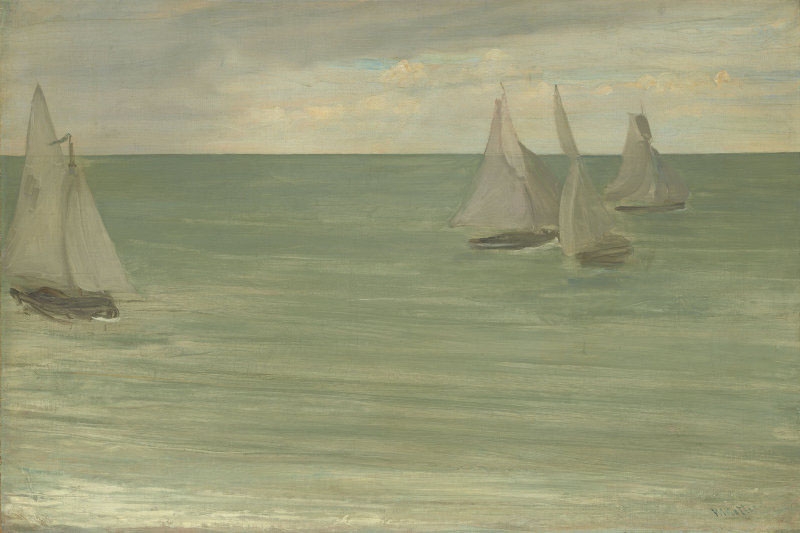Titles
Several possible titles have been suggested:
- Possibly 'Fishing Boats' (1886/1887, Whistler). 1
- 'oyster smacks or fishing boats going out in the evening' (1892, Whistler). 2
- 'fishing smacks going out in the gloaming' (1892, Whistler). 3
- 'Marine with fishing smacks' (1892, Whistler). 4
- 'Green and Grey: The Oyster Smacks, Evening' (1892, Goupil's). 5
- 'Marina' (1899, 1st World of Art Exhibition). 6
- 'The Silver Sea (Grey and Silver)' (1902, Agnew's). 7
- 'Grey and Green. Marine' (1904, Copley Society, Boston). 8
- 'Trouville' (1980, YMSM). 9
- 'Trouville (Grey and Green, the Silver Sea)' (2015, Art Institute of Chicago). 10
There is some confusion regarding the appropriate title.
It is likely that this painting is the one exhibited by Whistler in 1892 as Green and Grey: The Oyster Smacks, Evening [YMSM 099]. The title adopted by the Art Institute of Chicago, 'Trouville (Grey and Green, the Silver Sea)', was a combination of alternative titles used by art dealers and curators. It is reasonable, in that the scene is Trouville, the colours are green and grey, while the more subjective word 'Silver' was often used by Whistler, and in this case was noted by Agnew's during Whistler's lifetime.
The title 'Trouville' was accepted by the 1980 catalogue raisonné, but it has been decided to alter this to the definitive Whistlerian title of 1892, 'Green and Grey: The Oyster Smacks, Evening'.
Description
A seascape, with a high horizon, in horizontal format. A placid grey/green sea under grey skies, with one small fishing boat under sail at left and three further out, at right.
Site
Trouville, a popular seaside resort on the coast of France.
Trouville fishing boats were usually single masted and sloop- or cutter-rigged. A sloop has one jib (triangular sail) before the mast, a cutter has two. They were all gaff-rigged, having a four-sided mainsail with a boom at the bottom, the mast forward, and a gaff (the spar at the top).
Whistler's boats were admittedly painted rather sketchily, and contemporary descriptions suggest that no-one (not even the artist) was sure if the boats were fishing boats, oyster smacks, or other small craft. However, it looks as if the nearest boat has two sails forward, one to the end of the bowsprit, and a second to the top of the stempost. It is probably a gaff-rigged (fishing) cutter. The others are probably the same: all four appear to be fishing boats. 11
Jean-Désiré-Gustave Courbet (1819-1877) was in Trouville at the same time as Whistler, and painted some 35 seascapes during the autumn, of which one, The Fishing Boat (1865, Metropolitan Museum of Art) shows a rather battered looking small fishing boat on the beach. It was more convenient to paint boats drawn up on the beach, although several artists, including Claude Oscar Monet (1840-1926), certainly painted boats offshore from the late 1860s on, including Fishing Boats at Sea (ca 1866, The Hill-Stead Museum).
Comments
The Art Institute of Chicago website comments:
'In the early 1860s, James McNeill Whistler began to develop an art-for-art’s-sake aesthetic, eschewing narrative or naturalistic details to focus more intently on formal concerns. In 1865 ... he ... experimented with a series of increasingly simplified seascapes. The spare composition of this work … reveals Whistler’s interest in Japanese woodblock prints and the new models they offered for the construction of painted space and depth. The sweeping, horizontal brush strokes and highly restrained palette … further contribute to the innovative, flattened perspective of this painting.' 12
Notes:
1: List, [1886/1887], formerly dated [4/11 January 1892], GUW #06795.
2: Whistler to D. C. Thomson, 28 February [1892], GUW #08213.
3: Whistler to D. C. Thomson, 10 March [1892], GUW #08358.
4: Whistler to G. Coronio, draft, [1/15 August 1892], GUW #00694.
5: Nocturnes, Marines & Chevalet Pieces, Goupil Gallery, London, 1892 (cat. no. 29).
6: 1st World of Art Exhibition, Schtiglitz School, Saint Petersburg, 1899 (cat. no. 280)
7: July 1902, Messrs Agnew's records, London.
8: Oil Paintings, Water Colors, Pastels and Drawings: Memorial Exhibition of the Works of Mr. J. McNeill Whistler, Copley Society, Boston, 1904 (cat. no. 12).
9: YMSM 1980 [more] (cat. no. 70).
10: Art Institute of Chicago website at http://www.artic.edu/aic/collections/artwork/81572.
11: Many thanks to Iain P. MacInnes, naval architect and historian, for this information.
12: Art Institute of Chicago website at http://www.artic.edu/aic (acc. 2019)
Last updated: 14th December 2020 by Margaret






